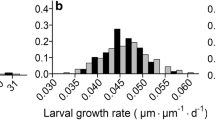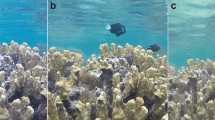Abstract
Despite the importance of foraging activity for the growth/predation risk trade-off, studies that demonstrated predator-induced survival selection on foraging activity under semi-natural conditions are relatively rare. Here, we tested for fish-induced selection for reduced foraging activity in two larval Enallagma damselflies using a field enclosure experiment. Fish imposed considerable mortality in both damselfly species and survival selection on foraging activity could be detected in Enallagma geminatum. We did not detect selection in Enallagma hageni, probably because this species already was not eating very much in the absence of fish compared to E. geminatum. Both species responded strongly to the presence of predators by reducing their foraging activity. The documented survival selection on foraging activity was detected despite the already low activity levels in fish lake prey species and despite strong predator-induced plasticity in this trait.


Similar content being viewed by others
References
Anholt BR (1997) How should we test for the effect of adaptive variation in behaviour on population dynamics? Evol Ecol 11:633–640
Anholt BR, Werner EE (1995) Interaction between food availability and predation mortality mediated by adaptive-behavior. Ecology 76:2230–2234
Anholt BR, Werner EE (1998) Predictable changes in predation mortality as a consequence of changes in food availability and predation risk. Evol Ecol 12:729–738
Biro PA, Post JR, Parkinson EA (2003) From individuals to populations: prey fish risk-taking mediates mortality in whole-system experiments. Ecology 84:2419–2431
Biro PA, Abrahams MV, Post JR (2007) Direct manipulation of behaviour reveals a mechanism for variation in growth and mortality among prey populations. Anim Behav 73:891–896
Brodin T, Johansson F (2004) Conflicting selection pressures on the growth/predation risk trade-off in a damselfly. Ecology 85:2927–2932
Brown H, Prescott R (1999) Applied mixed models in medicine. Wiley, Chichester
Cousyn C, De Meester L, Colbourne JK, Brendonck L, Verschuren D, Volckaert F (2001) Rapid, local adaptation of zooplankton behaviour to changes in predation pressure in the absence of neutral genetic changes. Proc Natl Acad Sci USA 98:6256–6260
DeWitt TJ, Sih A, Hucko JA (1999) Trait compensation and cospecialization in a freshwater snail: size, shape and antipredator behavior. Anim Behav 58:397–407
Duckworth RA (2009) The role of behavior in evolution: a search for mechanism. Evol Ecol 23:513–531
Endler JA (1986) Natural selection in the wild. Monographs in population biology 21. Princeton University Press, Princeton
Huey RB, Hertz PE, Sinervo B (2003) Behavioral drive versus behavioral inertia in evolution: a null model approach. Am Nat 161:357–366
Johansson F, Stoks R (2005) Adaptive plasticity in response to predators in dragonfly larvae and other aquatic insects. In: Fellowes MDE, Holloway GJ, Rolff J (eds) Insect evolutionary ecology. CABI Publishing, Walford, pp 347–370
Krivan V (2007) The Lotka–Volterra predator–prey model with foraging predation-risk trade-offs. Am Nat 170:771–782
Lima SL (1998) Stress and decision making under the risk of predation. Recent developments from behavioral, reproductive, and ecological perspectives. Adv Stud Behav 27:215–290
Lima SL, Bednekoff PA (1999) Temporal variation in danger drives antipredator behavior: the predation risk allocation hypothesis. Am Nat 153:649–659
Lind J, Cresswell W (2005) Determining the fitness consequences of antipredation behavior. Behav Ecol 16:945–956
Losos JB, Schoener TW, Spiller DA (2004) Predator-induced behaviour shifts and natural selection in field-experimental lizard populations. Nature 432:505–508
McPeek MA (1990a) Determination of species composition in the Enallagma damselfly assemblage of permanent lakes. Ecology 71:83–98
McPeek MA (1990b) Behavioural differences between Enallagma species (Odonata) influencing differential vulnerability to predators. Ecology 71:1714–1726
McPeek MA (1997) Measuring phenotypic selection on an adaptation: lamellae of damselflies experiencing dragonfly predation. Evolution 54:459–466
McPeek MA (1998) The consequences of changing the top predator in a food web: a comparative experimental approach. Ecol Monogr 68:1–23
McPeek MA (2004) The growth/predation-risk trade-off: so what is the mechanism? Am Nat 163:E88–E111
McPeek MA, Grace M, Richardson JML (2001) Physiological and behavioral responses to predators shape the growth/predation risk trade-off in damselflies. Ecology 82:1535–1545
Mikolajewski D, Johansson F (2004) Morphological and behavioral defenses in dragonfly larvae: trait compensation and cospecialization. Behav Ecol 15:614–620
Millar RB, Anderson MJ (2004) Remedies for pseudoreplication. Fish Res 70:397–407
Mortensen L, Richardson JML (2008) Effects of chemical cues on foraging in damselfly larvae, Enallagma antennatum. J Insect Behav 21:285–295
Skelly DK (1994) Activity level and the susceptibility of anuran larvae to predation. Anim Behav 47:465–468
Slos S, Stoks R (2006) Behavioural correlations may cause partial support for the risk allocation hypothesis in damselfly larvae. Ethology 112:143–151
Stoks R (1998) Effect of lamellae autotomy on survival and foraging success of the damselfly Lestes sponsa (Odonata: Lestidae). Oecologia 117:443–448
Stoks R (1999) Autotomy shapes the trade-off between seeking cover and foraging in larval damselflies. Behav Ecol Sociobiol 47:70–75
Stoks R, De Block M (2000a) The influence of predator species and prey age on the immediate survival value of antipredator behaviors in a damselfly. Arch Hydrobiol 147:417–430
Stoks R, Johansson F (2000b) Trading off mortality risk against foraging effort in damselflies that differ in life cycle length. Oikos 91:559–567
Stoks R, McPeek MA (2003) Antipredator behavior and physiology determine Lestes species turnover along the pond-permanence gradient. Ecology 84:3327–3338
Stoks R, McPeek MA (2006) A tale of two diversifications: reciprocal habitat shifts to fill ecological space along the pond permanence gradient. Am Nat 168:S50–S72
Stoks R, McPeek MA, Mitchell JL (2003) Evolution of prey behavior in response to changes in predation regime: damselflies in fish and dragonfly lakes. Evolution 57:574–585
Stoks R, De Block M, Van de Meutter F, Johansson F (2005) Predation cost of rapid growth: behavioural coupling and physiological decoupling. J Anim Ecol 74:708–715
Strobbe F, McPeek MA, De Block M, De Meester L, Stoks R (2009) Survival selection on escape performance and its underlying phenotypic traits: a case of many-to-one mapping. J Evol Biol 22:1172–1182
Tilman D (1987) The importance of the mechanisms of interspecific competition. Am Nat 129:769–774
Tollrian R, Harvell CD (1999) The ecology and evolution of inducible defenses. Princeton University Press, Princeton
Travis J, Reznick DN (1998) Experimental approaches to the study of evolution. In: Resetarits WJ, Bernardo J (eds) Experimental ecology: issues and perspectives. Oxford University Press, New York, pp 437–459
Van Buskirk J, McCollum SA (2000) Functional mechanisms of an inducible defence in tadpoles: morphology and behaviour influence mortality risk from predation. J Evol Biol 13:336–347
Van Buskirk J, McCollum SA, Werner EE (1997) Natural selection for environmentally induced phenotypes in tadpoles. Evol 51:1983–1992
Wellborn GA, Skelly DK, Werner EE (1996) Mechanisms creating community structure across a freshwater habitat gradient. Annu Rev Ecol Syst 27:337–363
Werner EE, Anholt BR (1993) Ecological consequences of the trade-off between growth and mortality rates mediated by foraging activity. Am Nat 142:242–272
Wissinger SA, Whiteman HH, Sparks GB, Rouse GL, Brown WS (1999) Foraging trade-offs along a predator permanence gradient in subalpine wetlands. Ecology 80:2102–2116
Acknowledgments
Special thanks to Luc De Meester, who helped collect the larvae and to the parents of FS, Etienne and Georgette, and Uncle Raf, who helped during the field work in McDaniel's Marsh while showing off their canoe skills, and in the laboratory by picking out damselfly larvae, and two anonymous reviewers for their suggestions. FS was supported as a Ph.D. fellow of the Institute for the Promotion of Innovation through Sciences and Technology in Flanders (IWT-Vlaanderen). MDB is postdoctoral fellow of the Research Foundation Flanders (FWO). This study was funded by FWO research grants and projects of the KULeuven Research Found to RS and NSF grant DEB-0516104 to MAM.
Author information
Authors and Affiliations
Corresponding author
Additional information
Communicated by: J. Choe
Rights and permissions
About this article
Cite this article
Strobbe, F., McPeek, M.A., De Block, M. et al. Fish predation selects for reduced foraging activity. Behav Ecol Sociobiol 65, 241–247 (2011). https://doi.org/10.1007/s00265-010-1032-y
Received:
Revised:
Accepted:
Published:
Issue Date:
DOI: https://doi.org/10.1007/s00265-010-1032-y




